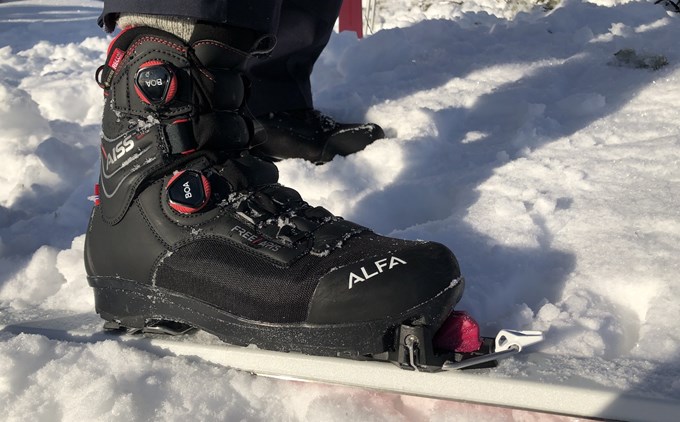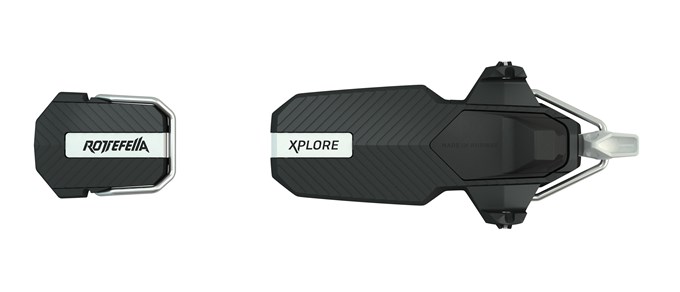What is this?
Rottefella Xplore Off-Track is a completely new binding system for backcountry skis. It is designed to give you significantly better support and more stability than offered by current BC bindings. At the same time, there has been no desire to compromise on walking performance for the sake of handling ability. Rottefella has developed both the Xplore bindings and Xplore shoe soles, while Alfa is launching three boot models with Rottefella Xplore. More boot manufacturers will get out onto the tracks over time.
The binding has a great deal in common with the front piece on the tech randonee bindings, but here the system is reversed. The spring-loaded spikes are in the shoe, not the binding. For the truly dedicated, this system may resemble the Dynafit P49. The binding consists of a broad claw, with holes in the sides into which the spikes from the shoe enter. At the front of the shoe is a flexible pad which provides bending resistance. The flexible pad is available in three stiffnesses: No resistance, normal resistance, and high resistance. The pads can be easily replaced. If you are going up a steeper hill, you can use the flat flexible pad without resistance on the way up, and ski down with the stiffest pad for maximum stability on the way down.

Shoes – Alfa Free A/P/S
The shoes we got to test were Alfa's new top model, Alfa Free A/P/S. In the backcountry ski world's relatively traditional shoe range, Alfa Free is a real breath of fresh air. This is a high boot that comes well over the ankle. It has an internal ankle support, which is hidden in the construction. The ankle support gives you some of the feeling you get from a boot for cross-country skiing. The lacing system consists of two separate BOA tensions. One tightens around the lower part of the foot, while the other tightens around the ankle and the lower part of the calf. You should therefore be able to wear it loose on light terrain, tighten it around your ankle in challenging downhill rides.
First test trip
Our testing day was a cold sunny day at the end of January. At the bottom, the snow had frozen over after mild weather a few days earlier. We took a detour up to Varingskollen so that we could test the bindings everywhere, from flat terrain to steep slopes, both uphill and downhill. The first thing that struck us was how easy it was to step in and out of the binding. Here is a step-in solution for entry. When exiting you can use the front lever rod.
On the way up, we noticed a clear difference between the various flexible pads. The normal pad gave more or less the same resistance as normal BC bindings, while the flat pad gave the feeling of wearing a randonnee binding. On uphill slopes, it felt very nice to wear the flat pad, while on flat terrain it felt more natural to wear the normal pad. This might be different after a little getting used to. Switching between the different flexible pads was so quick and easy that we envisage being able to do this several times during a trip
It was only when we headed downhill that we really noticed the great strengths of the new system. The shoes had a very rigid sole. Although the binding has no longitudinal grooves at the rear, there was no indication that we managed to twist the shoe out of position while skiing. When both BOA tensions were tight, the shoes provided exceptional support. Significantly better than we've known in any of today's back country ski boots. Since the binding is so wide, and the fastening is at the very edge of the shoes, the system also gave very good edge properties. We were able to ski down significantly more confidently than with the BC and 75 mm systems we already know. The stiffest flexible pad provided so much resistance that we didn't need any heel fastener. The skiing experience was impressive, and we think Rottefella and Alfa have got it spot-on.

Backcountry skiing revolution?
The big question is whether this will revolutionize back country skiing. After testing this, we believe that Rottefella and Alfa have made it possible to reach new destinations on downhill skis, at the very least. This largely fills the gap between backcountry skis and randone skis. You will be able to take longer runs than you would do with randone skis, and at the same time perform more difficult descents than you would with regular backcountry skis. In addition, the downhill runs are much more fun! With the different flexible pads, and the unique tensioning capability of Alfa Free, you get an incredibly versatile setup which is suitable for everything from peak runs to long runs on flat terrain. We look forward to further testing and to this coming onto the market in autumn 2021.
Jan Vidar Midtbø.
Do you have questions about Rottefella Xplore, Alfa Free A/P/S, or Alpine skis in general? Send me an email: janvidar@braasport.no.